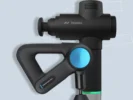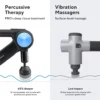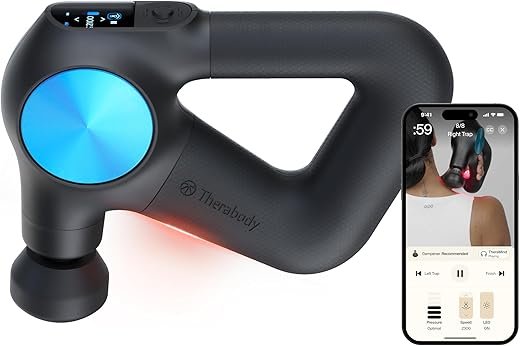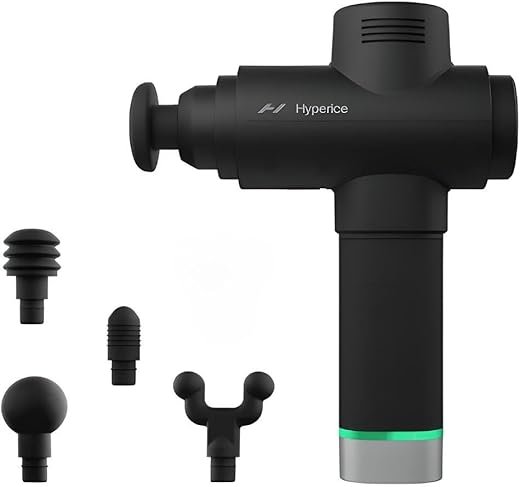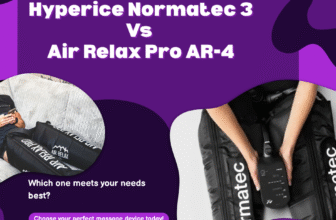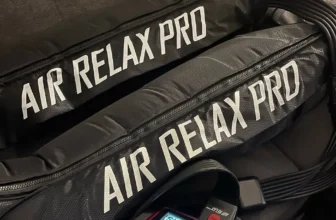Hypervolt 2 Pro vs Theragun Pro: Comparing Top Percussion Massagers for 2025
When it comes to recovery tools, picking the right massage gun can make a big difference in how your body feels and performs. I know it’s hard to choose between the top brands, but the Hypervolt 2 Pro and Theragun Pro both stand out as the best options for deep tissue relief and muscle recovery. Each one promises strong performance but has key differences in features, power, and price.
I’ve compared these two popular percussion massagers side by side, examining everything from the pressure they deliver to battery life and ease of use. You’ll find what sets them apart and which one might be better for your needs. Whether you train hard, deal with muscle soreness, or just want quick recovery at home, this detailed review aims to make your decision easier.
Therabody Theragun PRO Plus – 6-in-1 Deep Tissue Massage Gun with Heat, Vibration & Breathwork for Full-Body Muscle…
The Theragun PRO Plus by Therabody is a next-generation 6-in-1 deep tissue massage gun engineered for total-body muscle recovery and stress relief. Combining percussion therapy, vibration, heat, and cold therapy (sold separately), plus biometric breathwork guidance, it delivers unmatched performance for athletes, high-performers, and chronic pain sufferers.
Powered by Therabody’s latest tech, the PRO Plus improves mobility, reduces tension, and enhances mental focus through integrated breath training. Use the heated or vibrating attachments to target sore areas post-workout, or amplify recovery with app-guided routines.
Recharge via USB-C (power block not included). Whether you’re training hard or seeking better wellness, this multi-therapy massage gun is built for results.
Hyperice Hypervolt 2 Pro – Deep Tissue Percussion Massage Gun with Quiet Glide, 5 Speeds, 5 Attachments & Bluetooth…
Meet the Hypervolt 2 Pro, Hyperice’s most powerful deep tissue percussion massage gun—engineered to relieve stiff muscles, improve mobility, and accelerate recovery. Built with a 90W high-torque motor and Quiet Glide™ technology, this handheld massager delivers intense, whisper-quiet performance across 5 adjustable speed levels.
Whether you’re an athlete, desk worker, or fitness enthusiast, the 5 interchangeable heads (fork, ball, cushion, flat, bullet) let you target muscle groups with precision. Seamlessly connect to the Hyperice App via Bluetooth for guided warm-ups and recovery routines powered by HyperSmart™.
Compact, pro-level, and FSA/HSA approved, the Hypervolt 2 Pro is your go-to tool for muscle relief anytime, anywhere.
Key Takeaways
- Hypervolt 2 Pro and Theragun Pro are top choices for deep tissue massage.
- Key differences include power, noise, design, and price.
- The right pick depends on your recovery needs and budget.
Why Compare The Hypervolt 2 Pro And Theragun Pro?
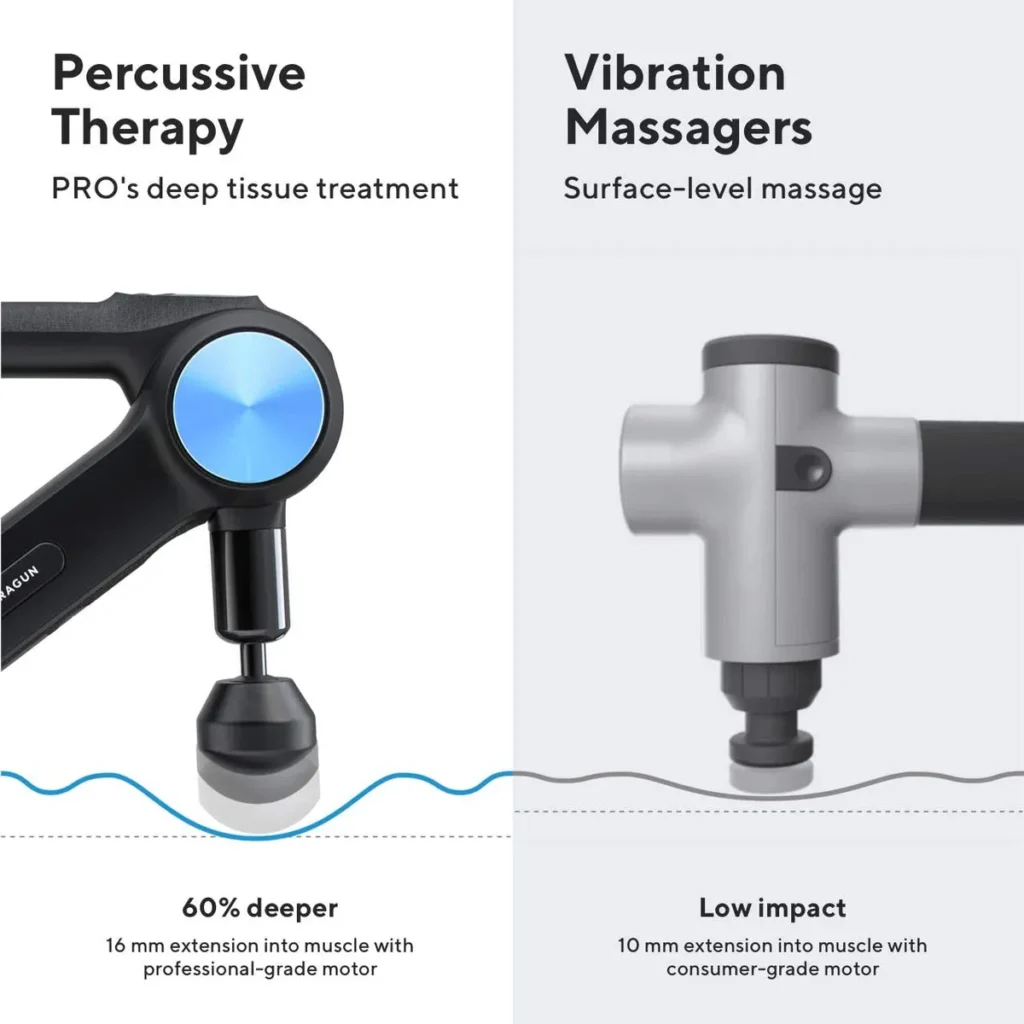
When I look at massage guns, the Hypervolt 2 Pro and Theragun Pro stand out as top choices. Both are known for deep tissue therapy and are used by athletes, trainers, and people needing recovery at home.
Comparing these two helps me find which one matches my needs and preferences. Each offers unique strengths when it comes to muscle relief and comfort.
Key features I consider include:
- Deep tissue effectiveness
- Stall force and amplitude
- Attachment variety
- Portability and weight
- Battery life
- Noise levels
- Ergonomics
- Price
Using these points, I can weigh practical differences for daily use. For example, the Theragun Pro is known for its higher amplitude, which means a deeper muscle massage. The Hypervolt 2 Pro, on the other hand, offers quieter operation and a more traditional design.
Here is a quick comparison:
| Feature | Hypervolt 2 Pro | Theragun Pro |
|---|---|---|
| Deep Tissue | Good, less amplitude | Very deep, higher amplitude |
| Stall Force | Strong | Stronger |
| Attachments | 5 heads | 6 heads |
| Portability | Lighter, easier to carry | Heavier |
| Battery Life | Around 3 hours | Up to 2.5 hours (removable battery) |
| Noise Levels | Quieter | Louder |
| Ergonomics | Standard grip | Ergonomic triangle handle |
| Price | Usually lower | Usually higher |
Comparing the Hypervolt 2 Pro and Theragun Pro helps me understand which massage gun fits my own therapy needs and budget. It also shows which features matter most to me in everyday recovery or athletic routines.
Quick Specs Comparison Table
Here is a side-by-side comparison of the Hyperice Hypervolt 2 Pro and Theragun Pro massage guns. I looked at the main specs that matter for deep tissue recovery and daily use.
| Feature | Hyperice Hypervolt 2 Pro | Theragun Pro |
|---|---|---|
| Amplitude | 14 mm | 16 mm |
| Stall Force | ~35 lbs | ~60 lbs |
| Attachments | 5 | 6 |
| Battery Life | Up to 3 hours | Up to 2.5 hours (two swappable batteries) |
| Weight | 2.6 lbs (1.18 kg) | 2.9 lbs (1.3 kg) |
| Noise Level | Quieter, less noticeable | Louder, especially on high settings |
| Ergonomics | Standard handle | Triangular, multi-grip handle |
| Price (approx.) | $399 | $599 |
The Theragun Pro offers a higher stall force and greater amplitude, making it more effective for deep tissue massage and breaking up muscle knots. I find it better suited for serious athletes or people who need strong massage power. The multi-grip handle also gives it a unique ergonomic advantage.
The Hyperice Hypervolt 2 Pro has a lighter build and runs quieter. It is easier to use in quiet environments or shared spaces like the living room. I also noticed that its battery lasts a bit longer, though the Theragun Pro’s extra swappable battery helps keep it going for longer sessions. You can read a more detailed breakdown comparing battery life and specs at this Mobility Athlete chart.
When carrying these devices, the Hypervolt 2 Pro’s lower weight makes it more portable. Its attachment system is also simple to use, although the Theragun Pro offers more grip options, which help during longer massage sessions.
The price gap between them is another key factor. If I need a stronger massage and advanced features, the Theragun Pro’s cost might be worth it. If I want something quieter and lighter, the Hypervolt 2 Pro is a solid choice. For those interested, Garage Gym Reviews also offers a thorough comparison of both devices.
Deep Tissue Performance
When I focus on deep tissue massage, both the Hypervolt 2 Pro and Theragun Pro offer solid performance. Percussion massage helps with sore muscles, boosts blood flow, and targets muscle tissue below the surface.
Stall force is a big difference. The Theragun Pro stands out with its 60 lb max stall force, which means I can apply more pressure without the device stalling. The Hypervolt 2 Pro has a lower, unspecified stall force, making it easier for the motor to stall during deeper tissue work. You can read more about this difference at Mobility Athlete’s detailed comparison.
| Feature | Hypervolt 2 Pro | Theragun Pro |
|---|---|---|
| Stall Force | Not stated (lower) | 60 lbs |
| Amplitude | 14 mm | 16 mm |
| Attachments | 5 heads | 6 heads |
| Battery Life | ~3 hours | ~2.5 hours |
| Noise Level | Quieter | Louder |
| Weight | 2.6 lbs | 2.9 lbs |
| Price (USD) | $329 | $599 |
The Theragun Pro’s higher amplitude (16 mm) provides a deeper hit to muscle tissue, which I find useful for tough, sore areas. The Hypervolt 2 Pro’s 14 mm amplitude gives a slightly less deep massage, making it more gentle on sensitive muscles.
For sore muscles or serious deep tissue work, I prefer the Theragun Pro, mainly for its stronger stall force and deeper amplitude. But, when I want quieter sessions or need more portability, the Hypervolt 2 Pro has advantages with its lower noise and lighter build. Both come with multiple attachments, so I can adjust for sensitive spots or tougher muscle groups.
Speed, Stall Force, And Amplitude
When I look at speed and intensity levels, both the Hypervolt 2 Pro and Theragun Pro offer multiple settings. The Hypervolt 2 Pro gives me 5 speed options, letting me adjust from a gentle massage to higher intensity for sore muscles. The Theragun Pro also features 5 speed modes, which makes it easy for me to fine-tune the level of intensity.
Stall force is how much pressure I can apply before the device stalls. The Theragun Pro goes up to 60 pounds of stall force, while the Hypervolt 2 Pro’s stall force is about 30-35 pounds. This means I can apply more pressure with the Theragun Pro for deeper tissue work, which is great if I need stronger massage power.
The next major factor is amplitude—the distance the head travels with each percussion. Theragun Pro leads here, offering a 16mm amplitude. The Hypervolt 2 Pro has a shorter amplitude, so it doesn’t reach as deep with each hit. This makes a difference for deep tissue massage, as I feel the Theragun working further into my muscles.
Here’s a quick side-by-side table:
| Feature | Hypervolt 2 Pro | Theragun Pro |
|---|---|---|
| Speed Levels | 5 | 5 |
| Stall Force | 30-35 lbs | 60 lbs |
| Amplitude | Shorter (<16mm) | 16mm |
When I want higher pressure and reach, the Theragun Pro stands out. For milder use or less force, the Hypervolt 2 Pro works well.
Design And Usability
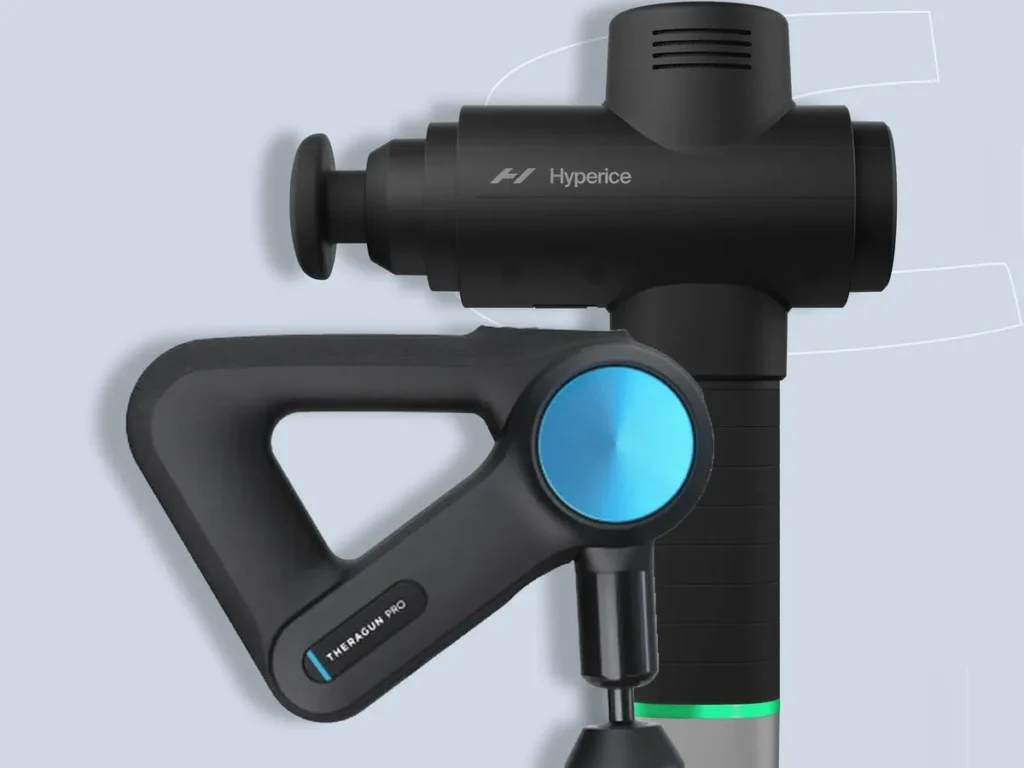
The Hypervolt 2 Pro and Theragun Pro employ distinct design approaches. The Theragun Pro, made by Therabody, uses a unique triangular grip that feels comfortable in my hand from different angles. The Hypervolt 2 Pro, from Hyperice, features a more traditional straight handle, which is simple and easy to hold.
| Feature | Hypervolt 2 Pro | Theragun Pro |
|---|---|---|
| Handle Shape | Straight cylinder | Triangular multi-grip |
| Adjust Arm | No | Yes |
| Weight | About 2.6 lbs | About 2.9 lbs |
| Attachments | 5 heads | 6 heads |
| Battery Life | Up to 3 hours | Up to 2.5 hours |
| Noise Level | Quiet for its class | Noticeable but not loud |
Both massage guns come with multiple attachments for different muscle groups. I find that the Theragun Pro has a slight edge here since it includes six heads and an adjustable arm. That makes it easier for me to reach tricky spots without help.
Hyperice has designed the Hypervolt 2 Pro to be user-friendly and travel-ready for a home gym or to take on the go. Its battery life is also longer, which matters if I’m moving between places or don’t want to charge often.
The Theragun Pro’s grip and ergonomic features stand out, especially for deep tissue work. It’s easier to keep a firm hold even during high-pressure use. The noise is higher than the Hypervolt, but I don’t find it distracting during sessions.
For those looking for something even more portable, models like the Theragun Mini provide a compact choice. However, both the Hypervolt 2 Pro and Theragun Pro deliver more power, better attachments, and versatility compared to mini massage guns or lower models like the Theragun Prime or Theragun Elite.
Battery Life And Charging
When I compare the Hypervolt 2 Pro and Theragun Pro, battery life stands out. The Hypervolt 2 Pro lasts up to 3 hours on a single charge, while the Theragun Pro (5th Gen) offers about 2.5 hours of use per battery. These numbers can change with different speed settings and how much pressure I use.
The table below makes it easy to see the differences:
| Massage Gun | Battery Life | Charging Type | Swappable Battery |
|---|---|---|---|
| Hypervolt 2 Pro | Up to 3 hours | Proprietary Adapter | No |
| Theragun Pro (5th Gen) | 2.5 hours | USB-C | Yes (extra provided) |
I notice the Hypervolt 2 Pro uses a proprietary charger, so I need its specific adapter to charge. The newer Theragun Pro uses USB-C, which lets me charge it with more common cables when I’m on the go.
The Theragun Pro also has a swappable battery feature. This means I can swap in a charged battery instead of waiting for it to recharge. For extended use, this is helpful, especially if I don’t want long breaks between sessions.
If battery life is a top concern, the Hypervolt 2 Pro averages longer use per charge. But if I value flexibility and long sessions or travel a lot, Theragun Pro’s USB-C and swappable batteries stand out.
Noise Levels And Comfort
When I tested both massage guns, I noticed clear differences in noise levels. The Hypervolt 2 Pro runs quietly, usually between 65 and 70 decibels. The Theragun Pro can be a bit louder, often reaching 75 to 80 decibels on its highest setting. This can be important if I want to use the device while watching TV or talking to others.
Here’s a quick comparison:
| Hypervolt 2 Pro | Theragun Pro | |
|---|---|---|
| Decibel Range | 65-70 dB | 75-80 dB |
| Grip Style | Standard | Multi-grip triangle |
| Comfort | Light, less vibration in hand | More vibration, heavier |
I find the Hypervolt 2 Pro more comfortable for longer sessions. Its motor makes less noise, which feels less distracting. The handle is lighter and causes less hand fatigue.
The Theragun Pro is heavier and produces more vibration. The unique triangle handle does make it easier for me to reach tricky spots, but after a while, my hand starts to feel tired. Some people might like the solid feel, but I prefer a device that’s easy to hold for five minutes or more.
Users need to think about when and where they plan to use the massage gun. If I want something that won’t disturb others, the Hypervolt 2 Pro’s quieter operation stands out. For people who need to reach difficult areas on their back, the Theragun Pro’s triangle grip can help, even if it’s louder and heavier.
For more details on noise and comfort differences, I looked at test results found at Garage Gym Reviews and Coach Magazine. Both reviews mention the Hypervolt being quieter and lighter, while the Theragun is more powerful but noisier and heavier.
Price And Value
The price difference between the Hypervolt 2 Pro and the Theragun Pro is pretty noticeable. The Theragun Pro usually costs more and can be found starting around $599, while the Hypervolt 2 Pro is usually priced at about $399. This price gap makes it important to decide what features matter most to me before I choose.
Here is a quick table showing the price differences:
| Model | Approximate Price |
|---|---|
| Theragun Pro | $599 |
| Hypervolt 2 Pro | $349 |
For this higher price, the Theragun Pro gives me premium build quality and a more powerful motor. It also has a higher stall force and more amplitude, which means it can work deeper into muscles if I need that kind of massage. The Theragun Pro includes six different attachments, compared to five for the Hypervolt 2 Pro. More attachments can make the device more adaptable for different muscle groups.
The Hypervolt 2 Pro is more affordable but still offers strong performance. It includes core features that most users—like me—will need. The lower price can make it a better value for someone looking for dependable performance and portability at a reasonable cost.
I find the Hypervolt 2 Pro easier to carry and a bit lighter, making it good for travel or gym bags. The battery life is similar, though the Hypervolt sometimes lasts a bit longer per charge, depending on use.
For more details about what you get for the price, check out this direct price comparison. If I am on a budget or new to massage guns, the Hypervolt 2 Pro looks more appealing in terms of value. If I want the top performance and more power, the Theragun Pro may be worth the extra cost.
Pros And Cons Summary
When comparing the Hypervolt 2 Pro and Theragun Pro, I notice several important differences. Here’s a clear breakdown of the features that matter most.
| Feature | Hypervolt 2 Pro | Theragun Pro |
|---|---|---|
| Amplitude | 14 mm | 16 mm |
| Stall Force | ~27 lbs | ~60 lbs |
| Attachments | 5 | 6 |
| Battery Life | Up to 3 hours | Up to 2.5 hours |
| Weight | 2.6 lbs | 2.9 lbs |
| Noise | Quieter | Louder |
| Ergonomics | Standard handle | Angled multi-grip |
| Price | Lower | Higher |
Pros of Hypervolt 2 Pro:
- Quieter operation—I find it easier to use in shared spaces.
- Lighter and a bit easier to carry.
- Slightly longer battery life.
- Usually costs less than the Theragun Pro.
Cons of Hypervolt 2 Pro:
- Stall force is lower, so it may not be as strong for deep tissue work.
- Amplitude is less, meaning it doesn’t reach deep into muscles as much.
Pros of Theragun Pro:
- Higher stall force and amplitude, making it better for deep tissue massage.
- Angled handle design offers more ways to grip and reach tough spots.
- Includes more attachment heads for different muscle groups.
Cons of Theragun Pro:
- Heavier and noisier, which can be an issue if I need to use it quietly.
- Battery life is a little shorter.
- Usually more expensive compared to the Hypervolt.
Final Verdict – Which Should You Buy?
Below is a side-by-side table for a quick comparison:
| Feature | Hypervolt 2 Pro | Theragun Pro |
|---|---|---|
| Stall Force | Medium (Good for most users) | High (For deeper massage) |
| Amplitude | 14mm | 16mm (Deeper muscle reach) |
| Attachments | 5 (Fork, Ball, Cushion, Flat, Bullet) | 6 (Wide variety, including Thumb and Wedge) |
| Portability | Lighter (2.6 lb) | Heavier (2.9 lb) |
| Battery Life | Up to 3 hours | Up to 2.5 hours |
| Noise Level | Quieter | Louder |
| Ergonomics | Standard handle | Unique angled handle |
| Price | Lower | Higher |
If I want something powerful for deep tissue massage and need extra stall force, the Theragun Pro feels like the right pick. Its longer amplitude helps target tight muscles better, especially for athletes or those with dense muscle mass.
For users who need something quieter and lighter, the Hypervolt 2 Pro offers comfort, easier handling, and almost the same battery life. It’s great for home use, relaxing in front of the TV, or if carrying weight is a concern.
If value matters most to me, the Hypervolt 2 Pro’s lower price and smooth performance make it more approachable for everyday users. But for the widest range of attachment options and features, I would lean toward the Theragun Pro.
Both deliver high-quality muscle relief, but my choice depends mainly on how much power I need and where I plan to use it.


Frequently Asked Questions
I’ve noticed some important differences and similarities when comparing the Hypervolt 2 Pro and Theragun Pro. These details can help me decide which massage gun best meets my specific needs for recovery, power, and value.
What are the key differences in specifications between the Hypervolt 2 Pro and the Theragun Pro?
The Hypervolt 2 Pro weighs about 2.9 pounds and has five speed settings. Its battery lasts up to three hours per charge. The Theragun Pro is slightly heavier and includes two batteries, each running up to 2.5 hours.
Theragun Pro features a 16 mm amplitude, reaching deeper into muscle tissue. The Hypervolt 2 Pro provides less amplitude. Both devices include multiple attachments for different muscle groups, but Theragun Pro offers a more adjustable arm for better reach.
How do the noise levels of the Hypervolt 2 Pro compare with those of the Theragun Pro?
The Hypervolt 2 Pro is quieter during use and has a gentle, humming sound. I find it less likely to disturb others when using it in quieter settings or shared spaces.
The Theragun Pro tends to be louder, with a more mechanical, aggressive noise. This may be noticeable in small rooms or when watching TV at the same time. Users often mention the difference when they switch between the two devices.
Can the Hypervolt 2 Pro match the Theragun Pro in terms of power and performance?
The Theragun Pro is more powerful and penetrates muscle tissue with a deeper 16 mm amplitude. This allows for stronger deep tissue massage and can be helpful for stubborn muscle knots.
The Hypervolt 2 Pro is strong but doesn’t go as deep as the Theragun Pro. It’s still effective for sore muscles and recovery, but I notice less intensity when working on dense or tight muscles. It may be a better fit for those who want a milder massage.
What are the main advantages of the Theragun Pro over the Hypervolt 2 Pro?
Theragun Pro’s main advantage is its power and deeper reach into muscles. The adjustable arm allows me to target hard-to-reach spots. The extra battery is helpful if I need more than one session before charging.
It also comes with more attachments for different muscle types and needs. I like its clear digital controls and durability, especially for frequent or professional use. Battery life is long, and the device feels solid.
Which device provides better value for money: Hypervolt 2 Pro or Theragun Pro?
If I want a powerful, professional-grade device with deep tissue capabilities, the Theragun Pro may be worth the extra money. It costs more but offers features like an adjustable arm and an additional battery.
The Hypervolt 2 Pro is a more affordable choice and still ticks many boxes: long battery life, quieter operation, and effective muscle relief. According to recent prices, the Hypervolt 2 Pro often costs about half what the Theragun Pro does. For those on a budget, this means better value for money.
How do user experiences differ when using the Hypervolt 2 Pro versus the Theragun Pro?
Users often say the Hypervolt 2 Pro has a smoother, quieter massage. It’s easier to use in public or at home with others in the room. I find it gentler and more relaxing, especially for daily use.
People who use the Theragun Pro describe it as stronger and sometimes more intense or aggressive. It fits those who want deep tissue treatment or have tougher pain points. The extra noise and power may be too much for some, but perfect for serious athletes or heavy use. For more details on user experience and device feel, see this comparison of noise and performance.

